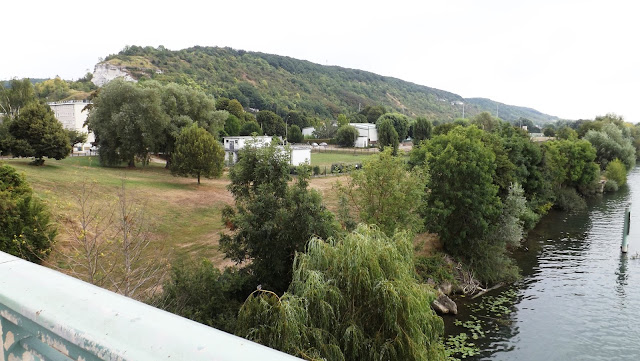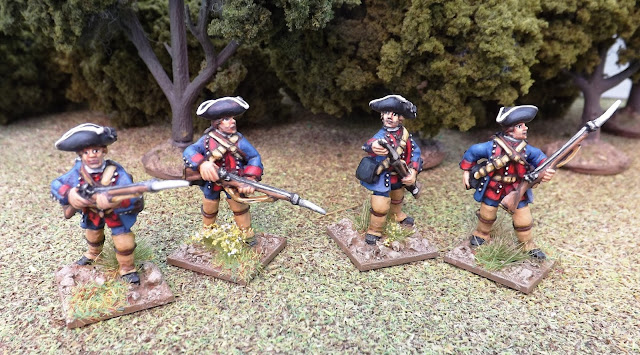 |
| A platoon of the 4th Wilts. heads out across the Seine into battle under a covering smoke screen at Vernon - 25th August 1944 |
We have rented a pretty little house near to Versailles and as well as taking in the palace and the great restaurants of Paris are checking out some of the other interesting places to visit on this side of Paris.
On Monday we drove out to Giverny on the River Seine ostensibly to visit Claude Monet's gardens where the famous Lilly on the pond pictures were inspired and it was while planning that trip that I realised the village was close to not only Vernon but also La Roche Guyon.
So I managed to get permission from the CEO of JJ's Wargames to include the other two venues into the day's agenda.
For those not so familiar with the significance of these two places, Vernon is the scene of Operation Neptune, the assault crossing of the River Seine carried out by the men of the 43rd Wessex Division in August 1944 and the Château at La Roche Guyon is the former headquarters of Field Marshal Erwin Rommel and German Army Group B during the build up to the invasion of France in 1944.
 |
| The map shows the close proximity of Vernon and La Roche Guyon handily positioned either side of Giverny |
I think assault river crossings are some of the most difficult and interesting military operations to study from Hannibal making his way through the Alps, to Wellesley's attack on Marshal Soult at Oporto in 1809, covered in some detail on this blog with the game of the battle. Perhaps one of the most audacious river assaults was led by Major Julian Cook of the US 3/504th PIR in their daring boat crossing across the River Waal to help capture the Nijmegan bridge made famous in the film "A Bridge too Far".
By the 22nd August 1944 the fighting in the Falaise pocket and the Battle of Normandy was over with the surviving German units in head-long retreat to the opposite bank of the River Seine and with the allies in hot pursuit,
The US 79th Division were already up to the Seine and advancing on Paris and the British XXX Corps were moving up towards Vernon with the XII Corps to their left.
 |
| The Divisional insignia of the "Fighting Wessex Wyverns" of 43rd Division |
General Brian Horrocks commanding XXX Corps had already determined to lead his drive over the Seine with two armoured divisions, Guards and 11th supported by 50th Division, whilst detailing the 43rd Division under Major General Ivor Thomas, to facilitate their progress with an assault on the crossing point at Vernon, to establish a bridgehead to allow the advance to continue.
 |
| Our Lady Collegiate Church, Vernon. Seventy-two years after the battle as seen below. The vehicle have changed a bit. |
The German defenders were well dug in and ensconced in the buildings that dotted the opposite bank armed principally with light machine-guns, mortars and 20mm auto-cannon positioned on the high-ground that oversees the river at this point.
 |
| The view of the German positions with the road leading along the opposite bank to the right of picture towards Giverny |
Many of the first wave boats and DUKWs were caught up in the shallows and grounded with their occupants caught in whithering machine-gun fire and it took the follow up waves taking advantage of gathering darkness and access to and via the partially destroyed bridge to get on to the opposite bank and clear the buildings in Vernonnet.
 |
| The view to the left of the German held back with less oversight from high ground behind but with a small island separating the two banks that obstructed an easy landing for the British troops |
 |
| The memorial to the British troops involved in the assault, on the position of the Engineer laid pontoon bridge seen below with 'Monty' crossing in the wake of his army. |
 |
| Monty crossing the Seine at Vernon on the 1st September 1944, the bridge being anchored to the tree in the background |
 |
| The modern day buildings below the white cliff mark the position of a rather troublesome machine gun bunker that caused the assault infantry a lot of difficulty |
 |
| The 17th century mill building on the remains of the old bridge leading out to the small island |
 |
| The Chateau des Tourelles was a fortress designed to guard the access to the old medieval bridge |
 |
| The building was badly damaged in 1944 and the extent of the which can be seen by the new build masonry that repaired the damage |
http://jjwargames.blogspot.fr/2013/09/today-in-1944-monday-september-18th.html
 |
| The small arms damage on the original stonework suggests that the Château was a point of resistance during the battle in 1944 |
I would like to have a go at re-fighting parts of this battle that raged over three days and I think a good set of company level rules like IABSM would be excellent to use for it - ah yet another project to think about! There is nothing quite like walking the ground to inspire thoughts of future games.
The next part of our trip up the Seine was to stop for lunch at La Roche Guyon and visit the former headquarters building of Army Group B and its very famous commander Field Marshal Erwin Rommel.
The Château of La Roche was first established in the 12th century as a castle tower atop the chalk cliffs with accommodation and other galleries tunnelled out in the chalk below. The building was further developed overtime into a fortified manor perfectly positioned to guard the crossing over the Seine.
The Château went through a further period of development from a medieval fortified house into an 18th century Château with a wing attached to the older structure and a corridor constructed through the extremely thick walls, which can be seen as you step through from the original building to the later creation.
Whilst walking through the large salon rooms now devoid of their period furniture it was not hard to imagine the babble of conversation as Rommel and Spiedel tried to win round Von Rundsteadt to the idea of fighting the allies on the beaches rather than run the gauntlet of allied air power to bring up the Panzer reserves.
 |
| Rommel and von Rundstedt at La Roche Guyon |
Rommel set up his headquarters here in February 1944 and it was here that a certain British Commando referred to as Lieutenant George Lane, although I think that might be a false name, was brought in May of 1944 after being captured taking samples off the beaches being looked at as potential landing areas for D Day.
The bore samples were all part of the learning that had developed as the allies developed their amphibious landing capabilities and became aware of understanding how suitable the beaches would be to taking tanks and allowing them to traverse the sand without risk of bogging.
It was on one of these reconnaissance missions that Lane had been captured and driven in the back of a truck, not knowing his fate, as Hitler had ordered that all British commandos should be shot when captured.
Perhaps it was in the room above that Lane was taken to meet with the Field Marshal who he described as most courteous and friendly, rising to greet the British officer with a handshake as he entered the room.
By the time Lane managed to get information about the location of Rommel's HQ to the allied command via French Resistance contacts, it was mid July and Rommel was on his way back to Germany following his wounding in an allied air attack.
The Field Marshall would soon be dead at his own hand to secure the safety of his family and staff and thus avoiding an embarrassing trial by the Nazi state, following his involvement in the plot to assassinate Hitler that month.
 |
| The view out across the Seine valley from the top of the Château |
What ever his political leanings, I think he was very much admired and respected by the British soldiers who faced him in North Africa, Italy and North East Europe and perhaps it should be left to Churchill to have the last word.
"We have a very daring and skillful opponent against us, and, may I say across the havoc of war, a great general"
http://www.worcestershireregiment.com/wr.php?main=inc/h_vernon
http://vernon-visite.org/rgb3/seine1944.shtml
http://ww2today.com/28-august-1944-over-the-seine-and-push-on
http://giverny.org/vernon/history/libegb.htm
http://www.historyofwar.org/bookpage/ford_seine_1944.html









































